Motor performance tests
Manual of the Motor Performance Tests
Worth, A., Woll, A., Albrecht, C. A., Karger, C., Mewes, N., Oberger, J., Schlenker, L., Schmidt, S. C. E., Wagner, M. O., & Bös, K. (2015). MoMo-Längsschnittstudie "Physical Fitness and Physical Activity as Determinants of Health Development in Children and Adolescents" : Testmanual zu den motorischen Tests und den anthropometrischen Messungen (KIT Scientific Reports ; 7700). Karlsruhe. https://doi.org/10.5445/KSP/1000047434
Reaction test (reaction speed)
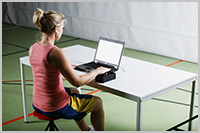 |
The participants have the task of reacting as quickly as possible to a total of 14 color changes of a traffic light by pressing a button located next to the laptop with the strong hand. The average reaction time and its standard deviation are recorded and evaluated. |
MLS line tracking (eye-hand coordination)
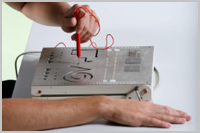 |
The "Motor Performance Series" (MLS) line tracking exercise is used to measure eye-hand coordination in precision tasks. The aim is to trace a milled line as quickly as possible with a stylus without touching the side walls or the base plate. The time taken to reach the end plate, the number of errors and the accumulated error duration are measured. These values can be used to determine coordination in precision tasks. |
MLS inserting pins (eye-hand coordination)
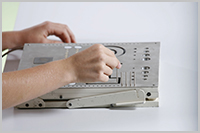 |
From a pin holder, 25 pins are to be inserted into the holes on the worktop as quickly as possible in the prescribed order. The pin holder is placed 20 (4-10 years) or 30 cm (11-29 years) away from the plate, depending on the age group. The exercise serves to test eye-hand coordination under time pressure. |
Single-leg stand (coordination in precision task, static)
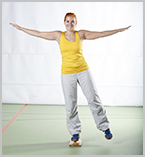 |
In the single-leg stand, sensorimotor regulation is tested in precision tasks. The person stands with the preferred leg on a 3 cm wide T-rail. The free leg must not touch the floor, the T-rail or the standing leg during the exercise duration (1 minute). Each contact counts as a fault point. After one minute, the number of fault points is noted and used for evaluation. |
Balancing backwards (coordination in precision task, dynamic)
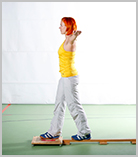 |
Balancing backwards on three wooden slats of different widths is used to test coordination in precision tasks and to test dynamic whole-body balance. For the exercise, the participants walk once forward and once backward over the slats. The exercise starts with the widest (6 cm; 4.5 cm; 3 cm). Then each participant has two valid attempts, during which the steps taken on the bar are counted. As soon as one foot touches the floor, the attempt is considered finished. A maximum of 8 steps are possible per attempt. |
Jumping sideways (coordination under time pressure)*.
* Part of the digital motor examination.
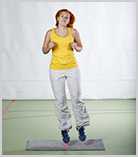 |
In jumping sideways, as many double-legged jumps as possible must be completed over the center line of a jumping mat within 15 seconds. Each jump performed with both legs that does not touch the center line and borders or leave the jumping mat counts as a point. After a break of one minute, a second attempt is made. This exercise measures large motor coordination under time pressure.
Digital version: No change in execution.
|
Stand and reach (Flexibility)*
* Part of the digital motor examination.
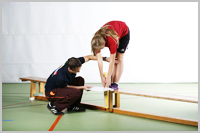 |
The stand and reach test is used to measure how far the participant's fingertips reach below the level of the soles of the feet with the knees extended. A centimeter scale attached to the platform specially made for this exercise is used to determine the result. The maximum final position must be held for at least 2 seconds in order to rule out any falsification of the result due to swinging. Again, the participant has two attempts. This exercise measures trunk flexibility and stretching ability of the back muscles.
Digital version: the exercise is performed without a platform while standing on a mat. It is measured whether the participant reaches the level of the soles of the feet or not.
|
Standing long jump (Speed Strength)
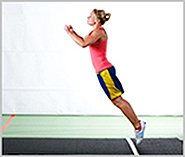 |
The standing long jump is used to determine the quickness of the leg muscles. The participants line up at a marker on the tartan granulate mat provided for this exercise. It is important to jump with both legs and not to fall backwards when landing. The jump would otherwise be invalid. Again, two valid attempts are relevant for the evaluation. |
Push-up (Dynamic Strength Endurance)*
* Part of the digital motor examination
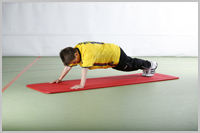 |
Since the push-ups are an exercise to determine the strength, or more precisely the strength endurance of the upper extremities, this exercise is not performed in the test battery for 4-5 year old children. The push-ups should be performed so that in the ground position the hands are briefly brought together behind the buttocks. In the support position, one hand touches the other. The push-ups should be performed cleanly, i.e. with the arms extended, only the hands and the feet should touch the floor. The whole exercise lasts 40 seconds. The number of correctly performed push-ups is noted and used for evaluation.
Digital version: No change in the execution.
|
Sit-ups (Dynamic Strength Endurance)*
* Part of the digital motor examination.
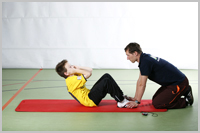 |
Sit-ups are also used to determine strength endurance and, accordingly, are not suitable for children up to 5 years. The exercise is performed lying down. The participant lies on his back with his legs bent. The feet are fixed by the test leader. The fingertips should touch the temples. Care must be taken to ensure that the arms do not raise the upper body, e.g. by pulling on the neck. The upper body should be raised until the elbows touch the knees. The upper body is lowered until the shoulder blades touch the mat. The pelvis should not leave the floor during the exercise. The exercise lasts 40 seconds, during which all valid sit-ups are counted and noted.
Digital version: No change in the execution. |
Ergometric test (Aerobic endurance)
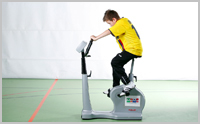 |
The cycling endurance test measures the aerobic endurance capacity of the participants. It is a step test, which means that the load increases after every two minutes. The test is started with an initial load of 25 watts for children and adolescents over 10 years of age. After 2 minutes, the load is increased by 25 watts, which corresponds to the internationally recognized WHO protocol (25W-25W-2min). Subjects aged 6 to 10 years are tested with the load protocol "15W-15W-2min". The test is terminated in children from 6 to 10 years of age at an achieved exercise heart rate of 190 beats/minute and in subjects from 11 years of age at an achieved exercise heart rate of 180 beats/minute over a minimum duration of 15 seconds. Furthermore, in both age groups, the test is terminated after the subjective stress limit is reached and when the speed drops below 50 revolutions for a minimum duration of 20 seconds. After the end of the test, the subject continues to ride at low resistance for 3 minutes. |
Hand force measurement (maximum strength)
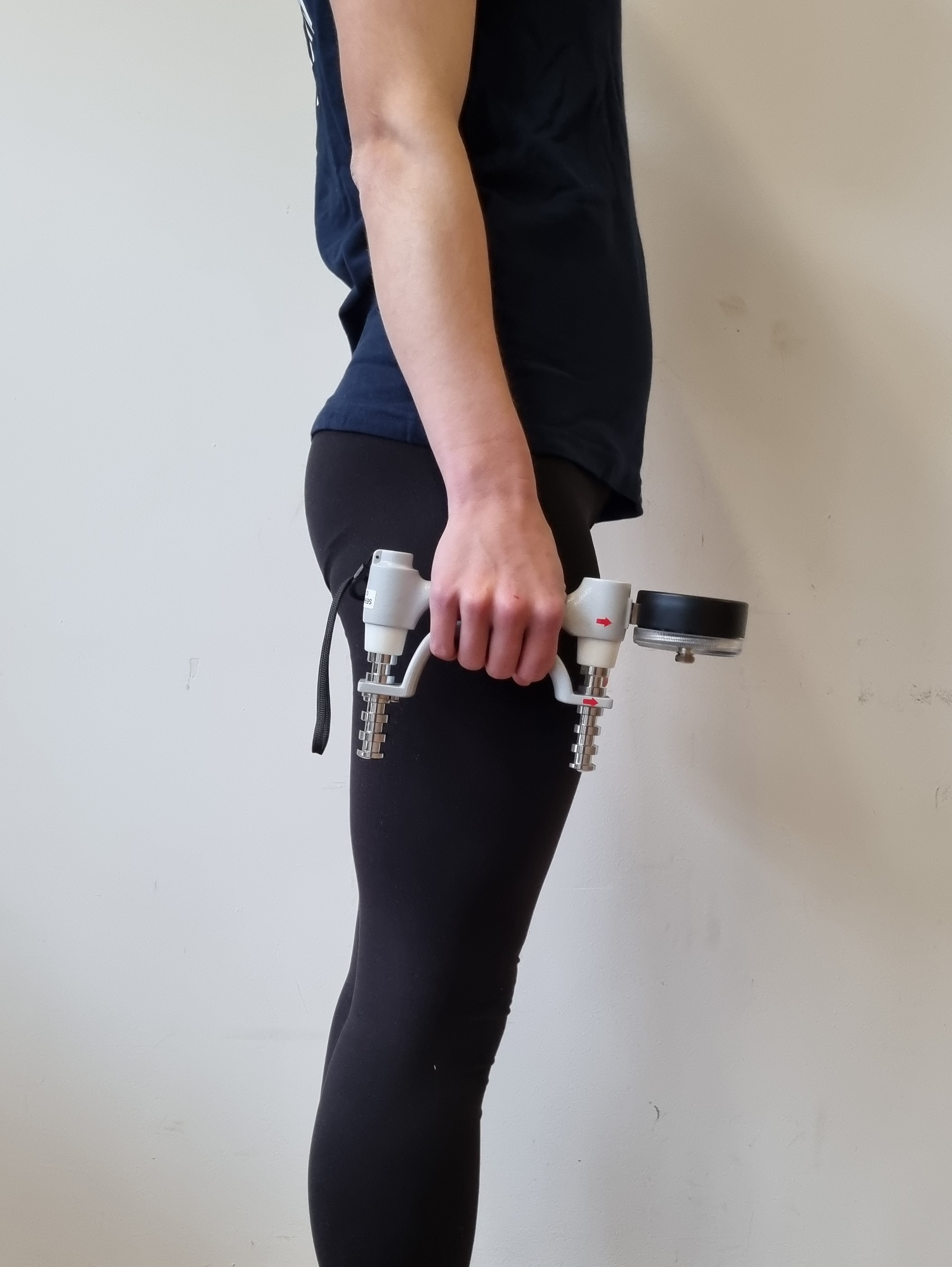 |
The hand grip test measures the maximum strength of the hand. Participants take a special hand force measuring device in their preferred hand and squeeze it as tightly as possible for 3 seconds. The test person performs this test twice. As this is an exercise to determine strength, or more precisely maximum strength, this exercise is not carried out in the test battery for 4-5 year old children. |

